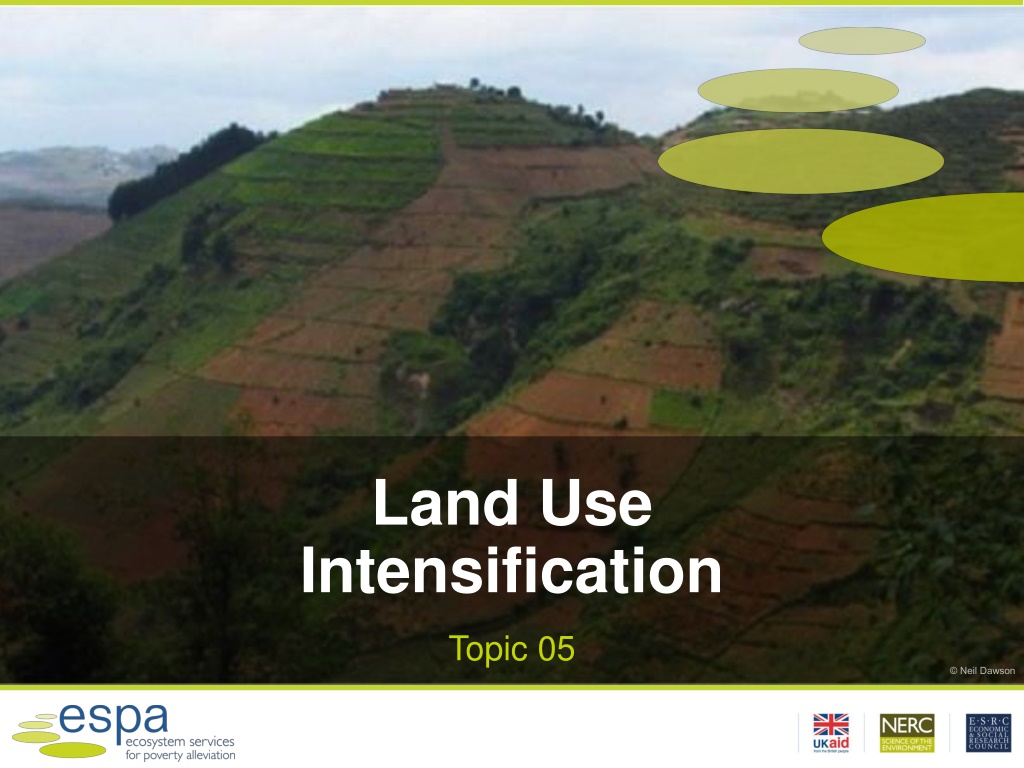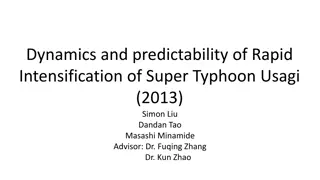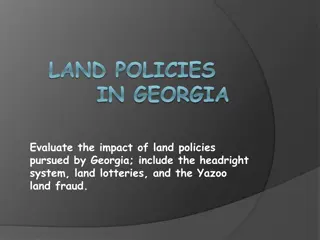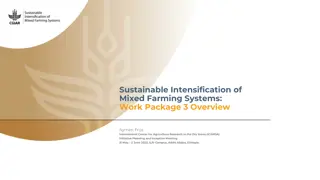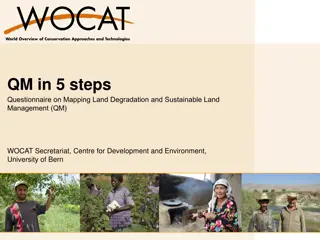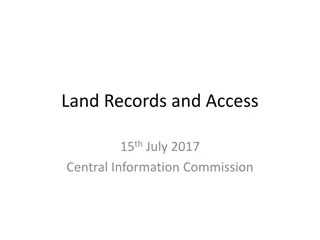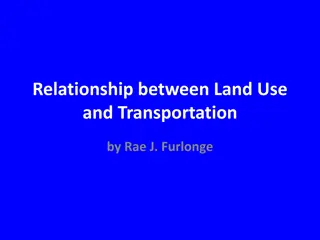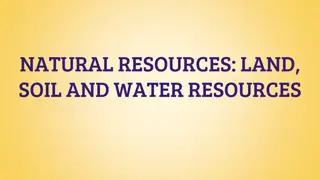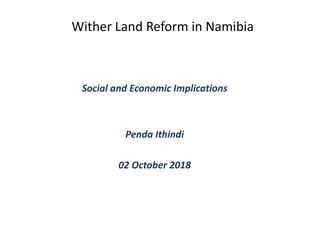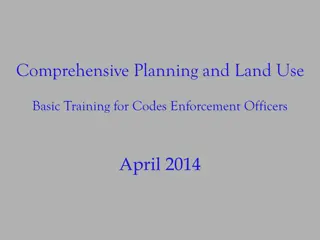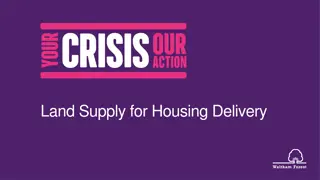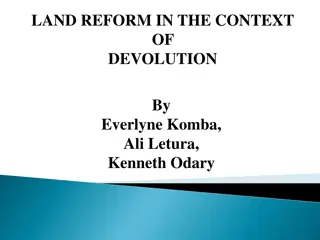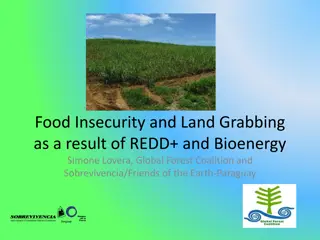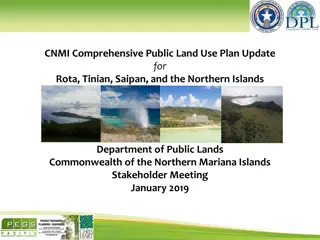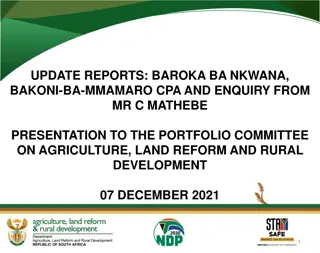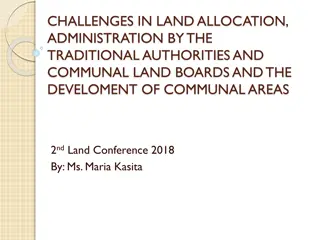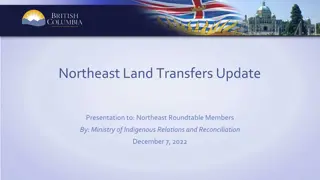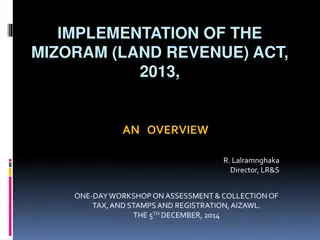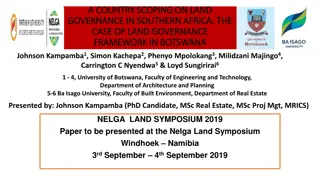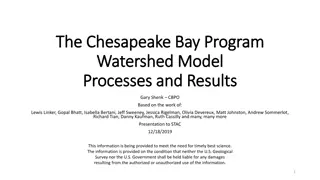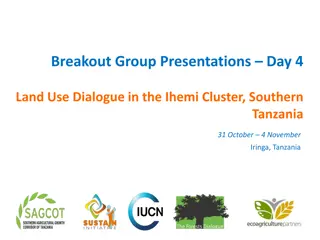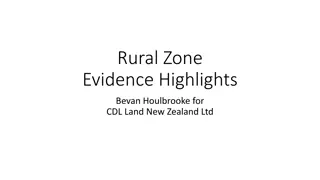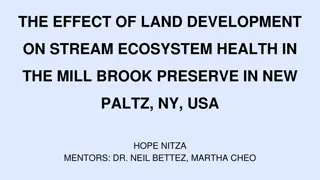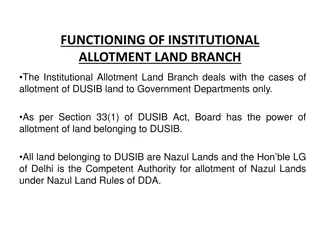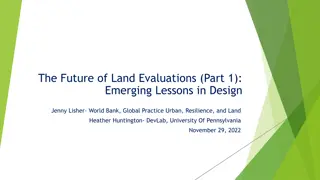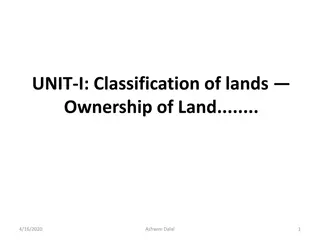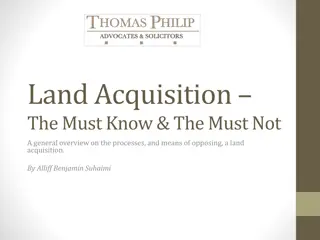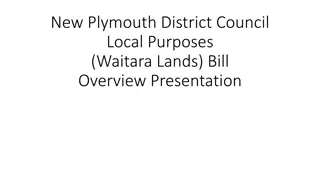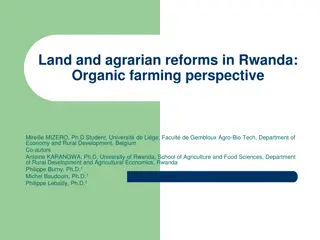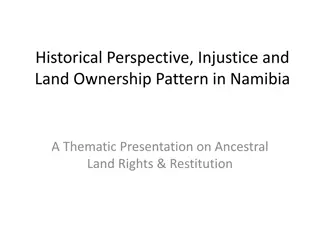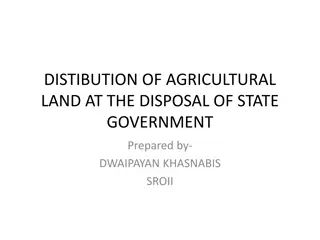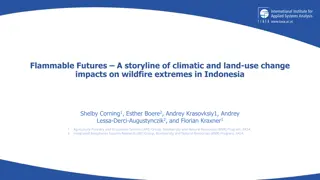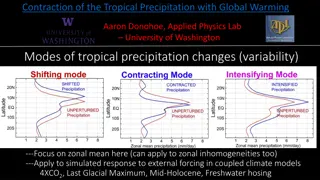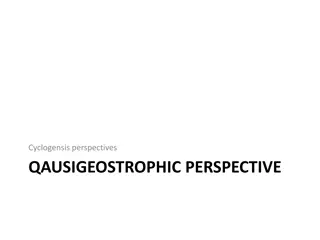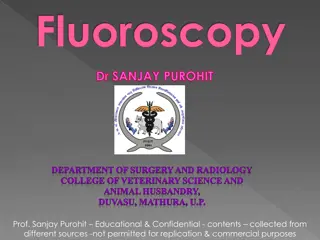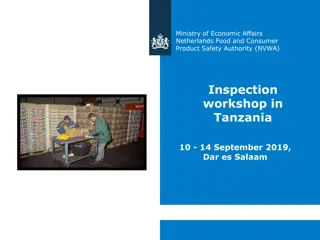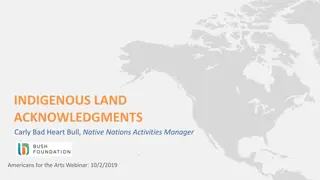Understanding Land Use Intensification and Its Impacts
Land use intensification is driven by increasing demands on ecosystems due to factors like population growth and changing dietary preferences. This process involves enhancing productivity through activities like land use conversion, increased inputs, and crop changes. Factors promoting intensification include higher market demand and scarcity of resources intensified by climate change. Addressing these challenges requires a balanced approach to maximize productivity while minimizing negative impacts on ecosystems and human well-being.
- Land Use Intensification
- Ecosystem Services
- Agricultural Intensification
- Human Well-being
- Sustainable Agriculture
Download Presentation

Please find below an Image/Link to download the presentation.
The content on the website is provided AS IS for your information and personal use only. It may not be sold, licensed, or shared on other websites without obtaining consent from the author. Download presentation by click this link. If you encounter any issues during the download, it is possible that the publisher has removed the file from their server.
E N D
Presentation Transcript
Land Use Intensification Topic 05
Learning outcomes Outline the main drivers for land use intensification Describe different components of land use intensification Analyse the impacts of agricultural intensification in relation to ecosystem services and human wellbeing
Increasing pressure and demands on ecosystems Human population is expected to reach 9 billion by 2050 - Higher incomes, changing lifestyles and dietary preferences May need a doubling of food crop production between 2005 and 2050 (Tilman et al. 2011) - Regional variation, e.g. 150% rise in demand for cereal crops expected in Ethiopia, Ghana, Tanzania (Franks et al. 2017) Land for production is declining in quantity and quality Competition for land for energy, fibre, biodiversity
Options for dealing with these pressures Reduce demand through behavioural change Ensure more equitable distribution of existing production Reduce waste Extensification (still possible in a few areas) Increase yields through intensification
What is land use intensification?
What is land use intensification? (Martin et al. 2018) activities undertaken with the intention of enhancing the productivity or profitability per unit area of rural land use, including intensification of particular land uses as well as changes between land uses 3 main types of land use intensification: Land use conversion (e.g. from fallows to permanent crops) Increased inputs (labour, irrigation, chemicals, machinery) Crop or product change (often involving high yielding varieties, and shifts from subsistence to cash crops)
Land use intensification process (Martin et al. 2018)
Factors promoting intensification Increased demand for outputs Population growth, in-migration, urbanisation Increased market demand (local to global) Demand for higher value added outputs Production factors Scarcity of land, water, labour intensified by climate change Availability of capital, entrepreneurship (skills and knowledge) Policies and institutions (formal and informal) Facilitating access to credit Land tenure and labour contracts
Impacts of land use intensification
Impacts of intensification 1. Social impacts (Martin et al. 2018) Win-Win outcomes are rare: few cases alleviate poverty and protect biodiversity and ecosystem services Complex trade-offs: benefits and losses are not evenly distributed between social groups Poor people are less able to access benefits of land use intensification
Rwandan Green Revolution case study (Dawson et al. 2016) 2008 Crop Intensification Program (CIP) aimed to transform agriculture Designated regions for 6 edible crop types and some cash crops, made approved seed types and subsidised fertilisers available Local officials had targets to meet, and could impose fines or reallocate land from farmers who fail to comply National statistics show that from 2006/7-11: - Income-based poverty fell from 57% to 45% - % of households using supplied seeds rose from 3% to 40% - Fertiliser use rose from 8 to 23kg/ha BUT 165 respondents in 8 villages in Western Rwanda: - Perceived wellbeing to be declining (though education & health were positive) - 12% had become landless in past decade - 84% had changed the food they ate (or ate fewer meals) - 37% ceased trading edible crops CIP disadvantaged marginalised groups because of economic barriers to comply, reduced tenure security and prohibited traditional agriculture
2. Environmental impacts Catchments and water management affected Soil disturbance and potentially increased soil erosion Loss of landscape diversity Negative impacts of higher fertiliser production and application (e.g. eutrophication) Positive impacts of fertilisers leading to increased crop yields which may have reduced greenhouse gas emissions Opportunity to set aside non-agricultural land for conservation
3. Biodiversity and ecosystem service impacts More specialised production process reduces crop and livestock species, often leading to monocultures High-yielding varieties replace traditional crop varieties, leading to a loss of genetic diversity Reduced plant species richness changes composition of the pest complex Nutrient inputs and chemical applications affect the competitive balance between different soil microbes Loss of local habitats and broader ecosystems Reduction in number and diversity of important species like pollinators
Laos case study: Land use intensification and disaggregated wellbeing outcomes (Broegaard et al. 2017) Land use intensification involves: (i) adoption of new cash crop (maize) in 2010, (ii) reduced fallows, (iii) increased inputs 2004-14: Poverty rates decreased from 59 20%, but food security also declined Phon Sang village (most intensified) - Significantly fewer wild foods including rodents - 77% of villagers did not replace lost protein through purchases - Wild plants (valued for medicine and greens) became weeds - Wild rodents (valued for food) became pests (of maize) - Fallows reduced yields declined farmers took out loans to buy inputs and began to illegally clear land in the protected area
Class exercise: Land use intensification in your environment Talk to your neighbour and look at slide 7 Can you think of an example of each of the following intensification types in your country? - Increased inputs - Land conversion - Crop change For each example, what are: - The main policy objectives? - The main social and environmental outcomes? Are these different for different people?
What is sustainable intensification? agriculture in which yields are increased without adverse environmental impact and without the cultivation of more land (Royal Society 2009)
Characteristics of sustainable agricultural intensification (Pretty and Bharucha 2014) Utilises crop varieties and livestock breeds with a high ratio of productivity to use of externally and internally derived inputs; Avoids the unnecessary use of external inputs; Harnesses agroecological processes such as nutrient cycling, biological nitrogen fixation, allelopathy, predation and parasitism; Minimises use of technologies or practices that have adverse impacts on the environment and human health; Makes productive use of human capital (knowledge and capacity to adapt) and of social capital to resolve landscape-scale issues Minimises the impacts of system management on externalities such as GHG emissions, clean water, carbon sequestration, biodiversity, and dispersal of pests, pathogens and weeds.
Interventions for sustainable agroecosystems (Pretty and Bharucha 2014) Crop variety improvements Integrated pest management Management-intensive rotational grazing systems Conservation agriculture - minimise soil disturbance, maintain soil cover and rotate crops Agroforestry System of rice intensification - low planting density, improvement of soil with organic matter, reduced water application and early seedling transplantation
Land sparing or sharing? Land sparing = separation of conservation and (intensive) production Land sharing = integration of conservation and (less intensive) production Talk to your neighbour and discuss the merits and drawbacks of land sparing versus land sharing for: - Biodiversity - Ecosystem services - Human wellbeing
Conclusions Ecosystem services, agriculture and human wellbeing are interlinked Intensification is a result of increased demand for output, changes in production factors and institutions and policies It is achieved through different processes (land use conversion, increased inputs, change in crops) Impacts on people and natural environments vary - Very few cases of intensification achieve both poverty alleviation AND maintain ecosystem services - Short-term income or productivity gains often lead to long-term loss of biodiversity and ecosystem services which lead to negative feedback on the wellbeing of marginalised groups Sustainable intensification might provide a way forward
References Key readings Martin, A. et al. (2018) Land use intensification: The promise of sustainability and the reality of trade-offs, Chapter 6 in Schreckenberg, K., Mace, G. and Poudyal, M. (eds) Ecosystem services and poverty alleviation: Trade-offs and governance. Routledge, Abingdon. Pretty, J. and Bharucha, Z.P. (2014) Sustainable intensification in agricultural systems. Annals of Botany 114: 1571-1596. Royal Society (2009) Reaping the benefits: science and the sustainable intensification of global agriculture. The Royal Society, London. Tilman, D. et al. (2011) Global food demand and the sustainable intensification of agriculture. Proceedings of the National Academy of Sciences108: 20260-20264. Other readings Broegaard, R.B. et al. (2017) Wild food collection and nutrition under commercial agriculture expansion in agriculture-forest landscapes. Forest Policy and Economics 84: 92-101. Dawson, N., Martin, A. and Sikor, T. (2016) Green Revolution in Sub-Saharan Africa: Implications of imposed innovation for the wellbeing of rural smallholders., World Development78: 204-218. Franks, P. et al. (2017) Reconciling forest conservation with food production in Sub-Saharan Africa: Case studies from Tanzania, Ethiopia and Ghana. Research Report, IIED, London.
Guided reading Please read: Mudombi, S. et al., (2018) Multi-dimensional poverty effects around operational biofuel projects in Malawi, Mozambique and Swaziland. Biomass and Bioenergy114: 41-54. Questions for discussion: 1. What impact has the intensification of land use for biofuel cultivation had on food security and multi-dimensional poverty in Malawi, Mozambique and Swaziland? 2. How do the impacts of jatropha and sugarcane differ and why? 3. What actions could governments take to minimise trade-offs from biofuel production?
